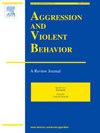Perpetrators of domestic abuse against older adults – a rapid evidence assessment
IF 3.4
2区 心理学
Q1 CRIMINOLOGY & PENOLOGY
引用次数: 0
Abstract
This rapid review examines the existing, published research on the demographic and health characteristics, and the offending behaviours and histories of perpetrators of domestic violence and abuse against adults aged 60 and over. Using a systematic methodology, searches were conducted in five databases: MEDLINE Complete, APA PsychInfo, CINAHL Complete, SociINDEX with Full Text, Criminal Justice Abstracts with Full Text, and Web of Science (Core Collection), resulting in 75 papers being included in the review. Much of the available evidence comes from the elder abuse field, with few specific domestic abuse studies. The review found that non-intimate partners, that is (adult) children or other family members, are the most frequently reported perpetrator group. Most perpetrators tend to be male, and, where information is available, poor health, and drug and alcohol problems are often reported. We conclude that we need to build more evidence on perpetrators of domestic violence and abuse using a wider methodology, which should be situated within the conceptual lens of domestic abuse, and that policy and practice should urgently review whether existing risk assessment tools and perpetrator programmes are suitable given most domestic abuse of older adults is perpetrated by younger sons, daughters or other family members.
家庭虐待老年人的肇事者——快速证据评估
这一快速审查审查了针对60岁及以上成年人的家庭暴力和虐待肇事者的人口和健康特征以及犯罪行为和历史的现有已发表研究。采用系统的方法,在MEDLINE Complete、APA PsychInfo、CINAHL Complete、SociINDEX(含全文)、Criminal Justice Abstracts(含全文)和Web of Science(核心合集)5个数据库中进行检索,结果有75篇论文被纳入综述。现有的证据大多来自老年人虐待领域,很少有具体的家庭虐待研究。审查发现,非亲密伴侣,即(成年)子女或其他家庭成员,是最常报告的施暴者群体。大多数施暴者往往是男性,而且,在可获得资料的情况下,经常报告健康状况不佳以及吸毒和酗酒问题。我们的结论是,我们需要使用更广泛的方法来建立更多关于家庭暴力和虐待肇事者的证据,这些方法应该位于家庭虐待的概念范围内,并且政策和实践应该紧急审查现有的风险评估工具和肇事者计划是否适用,因为大多数老年人的家庭虐待是由年幼的儿子,女儿或其他家庭成员实施的。
本文章由计算机程序翻译,如有差异,请以英文原文为准。
求助全文
约1分钟内获得全文
求助全文
来源期刊

Aggression and Violent Behavior
Multiple-
CiteScore
7.50
自引率
4.30%
发文量
63
期刊介绍:
Aggression and Violent Behavior, A Review Journal is a multidisciplinary journal that publishes substantive and integrative reviews, as well as summary reports of innovative ongoing clinical research programs on a wide range of topics germane to the field of aggression and violent behavior. Papers encompass a large variety of issues, populations, and domains, including homicide (serial, spree, and mass murder: sexual homicide), sexual deviance and assault (rape, serial rape, child molestation, paraphilias), child and youth violence (firesetting, gang violence, juvenile sexual offending), family violence (child physical and sexual abuse, child neglect, incest, spouse and elder abuse), genetic predispositions, and the physiological basis of aggression.
 求助内容:
求助内容: 应助结果提醒方式:
应助结果提醒方式:


